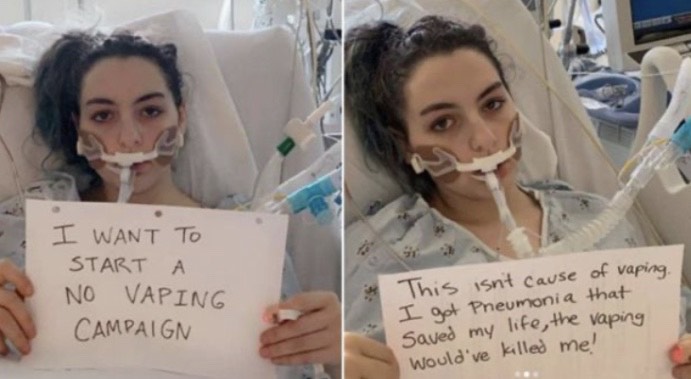Vaping’s kill streak has targeted teens
December 18, 2019
Just a year ago, Jenna Corrao wrote “The rise of JUULing” and Melissa Ellin published “Nicotine is never safe.” I’m here to tell you that the statistics are finally in. The scientists have spoken volumes. The vaping industry is getting exposed and people are dying.
Simah Herman, 18, is pictured on the right. She was almost another one of the victims. Now an anti-vaping advocate after she almost died, her words pictured ring true, but some are not as lucky.
There have been 1,300 injured and 29 people were killed due to a billion-dollar industry: vaping, known globally as e-cigarettes. Most were teens. Now, who would’ve thought this? Not teens. Many were under a different impression.
“I think the statistics are surprising because I’ve heard that nobody dies from vaping,” said Kavya Subramanian, a senior at Solon High School (SHS).
I mean, I heard the same thing, that vaping is ‘just like weed/marijuana’ and it can’t really kill you (but there’s no hard statistics on that either). Thus, we are just two of many who didn’t expect a death toll. Vaping is truly an epidemic that shows the human tendency to let history repeats itself. It’s quite sad actually.
In the 1950s, tobacco companies continued to produce cigarettes even though they realized by then that their product was dangerous and over time, lethal. Now, the e-cigarette market is doing the exact same. They’re still advertising themselves as healthier, cleaner, and an overall better alternative. Funny enough, they’re exactly the opposite. Take off their mask and you uncover the hidden incentives of advertising to teenagers, making vaping all the more popular with the youth especially. Why is this effective? Teen brains’ susceptibility to addiction.
Mrs. Joseph, an AP Psychology teacher at SHS, states the main reason for widespread addiction is because humans’ brains are not fully developed until the age of 25.
“The brain is still forming neural connections between cells and when we use those neural pathways over and over again it strengthens those connections,” Joseph said. “[And] with addiction… it’s hard to break those neural networks later since the networks [get] solidified before the networks have stopped developing.”
It’s because teens have way more neural plasticity and thus, a higher ability to alter our brains right now. Although addicts may know this, they still start drugs even though the risk of getting hooked is high.
“I think people sadly follow this phrase a lot: ‘taking leaps of faith on things they aren’t quite sure they are getting themselves into,” said Anthony Nasca, a SHS Senior and Students Against Destructive Decisions (SADD) officer.
Addicts can’t blame it on ignorance anymore because of all the media coverage. Now, a new excuse has stepped into play, flavors. Sweet, fruity flavors trap teens like flies.
“By using fun flavors to keep us interested, [and] in return, they have a customer for life,” Nasca said.
He’s right. And because of this, the critics who claimed these flavors were purely to attract new customers, teens, won their case and rightfully so. They were clearly marketing teens. JUUL announced in October of 2019 that they’d stop selling their cucumber, mango, and creme flavor pods.
“Since regular cigarettes don’t have a flavor, how could adding a flavor entice recovering addicts if they’re already addicted to a drug that has no flavor?” Subramanian said. “It just doesn’t make sense.”
Vaping has also been verified to have more nicotine than cigarettes. Yes, maybe it has less of other harmful chemicals (and only maybe), but not nicotine. How could this be any better than cigarettes? It depends on who is engaging in the harmful act.
“If you are a smoker, then moving on to vaping it [may] be better for you. As someone who’s never smoked, if you start with vaping it’s obviously worse,” Subramanian said.
The sad truth is that e-cigarettes aren’t always better for you. People could find themselves still stuck in a cycle of addiction.
“[People I knew] went to vaping because they thought it was safer,” Joseph said. “But one of them quit smoking and started vaping when that became popular, and that led to him smoking cigarettes [again].”
I fully believe that vaping is a gateway drug to cigarettes just like marijuana is for harder drugs like cocaine, heroin, and opioids. To understand the severity of what teenagers are getting into, they must understand this: once you get to the harder drugs, your time on this earth is limited. With vaping, you start the downfall.
So teens should try listening to their parents for this one, since ding ding ding, there’s a reason why they tell you to be careful. They want to see you grow up, eventually. Not die.
“Teens can practice making choices… and you’ll know how to say no,” Joseph said. “Parents [can give] kids tools to resist [temptations].”
Some of these “tools” were simply being good parents and giving them responsibilities. By allowing their children to make decisions and set their curfews, they can feel more secure and happy with themselves. This would also alleviate another temptation for vaping which may be due to one’s self-esteem and peer pressure. To break down the influence vaping has on teens, they must understand ways to combat it. SADD is doing just that.
“We had a lecture at the Cavs arena and the lecture was predominantly about vaping and its dangers,” Nasca said. “Everyone who attended that was delightfully enlightened.”
That’s a start, right? More teens must learn to understand the severity of vaping and that once you start, you become completely dependent on a selfish and life-threatening industry.

